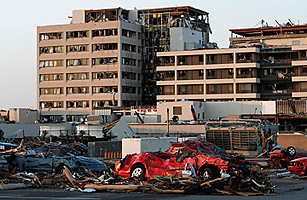
First, Terry Bigley watched the tornado overtake his television screen as it ripped through eastern Kansas toward Joplin, Mo., where he lived on the east side in an apartment with his wife. “They had a big picture of it,” he says of the local news station. “And I mean this was a humungous tornado. They told everybody to take cover. Then it was right on us.”
The Joplin tornado and a less powerful one that wreaked havoc in Minneapolis were both associated with a low-pressure system that mixed with a cold front, according to Chris Franks, a meteorologist with the National Weather Service in Chanhassen, Minn. The southwestern Missouri town of roughly 50,000 where Bigley, 64, has spent a lifetime was substantially demolished by what meteorologists are estimating to be an EF3, which is a tornado with wind speeds ranging from 136 m.p.h. to 165 m.p.h. Andy Boxell, a meteorologist with the National Weather Service in Springfield, Mo., says EF3s are rare, typically occurring once a year. The estimated EF3 that tore through Joplin was rare, too, Boxell says, because it was on the ground for only about 10 miles before dissipating. Normally twisters of that magnitude are on the ground longer, he explains.
But it was a devastating 10 miles. Joplin officials have reported 116 deaths and an unknown number of injuries. The tornado razed a hospital, a high school and at least 2,000 buildings, the AP reported. Bigley says that after emergency workers helped him and his wife — both of whom are disabled — out of their apartment, his block was “just a pile of sticks.”
“I got up and looked outside, and there were no buildings left,” he says. “There was a drugstore, and it was gone. All the parked cars, those were gone. Everywhere else, it’s just devastated. I don’t see how in the world anybody got out of there. I mean, it was nothing but piles of wood. It just looks like toothpicks after it got done.” Bigley, who took shelter with his wife in a closet during the twister, sustained minor cuts from flying shards of glass. “I was hoping we’d come out alive,” he says.
The death toll is expected to climb. In the aftermath of the tornado, Bigley says, he noticed a woman nearby running in circles, pleading for someone to help find her baby in a demolished apartment complex. “I felt for her like crazy,” he says. “But what can I do? There’s a big pile of rubble. There’s no machines down there, so how are you going to do it? Unless you’ve got some backhoes or scoop loaders, it’s going to be hard. And if you do find somebody, by chance that might be alive, you might injure them even worse than they are [during a rescue]. The chances of that are not too good — not after all that mess.”
In Minneapolis, a far less destructive storm left an urban jungle of uprooted trees that had fallen on homes and cars in one of the city’s poorest neighborhoods. It was the worst tornado to strike the Twin Cities area since at least 1984. The Hennepin County Medical Examiner reported one fatality. Hospitals reported at least 29 injuries. From 9 p.m. on May 22 until 6 a.m. on May 23, authorities imposed a curfew on the most damaged area after looters ransacked a liquor store. Around the time of the curfew, when the electricity was out, the neighborhood grew dark but remained peaceful, if heavily policed. Many neighbors helped one another in clearing out the damage and patching splintered houses. At midnight, police from three different departments said in interviews that they had not arrested anyone.
Survivors of both tornados say the twisters struck and dissipated rapidly. Meteorologist Franks says a siren is primarily a warning tool for people outside to take cover and that people should plan accordingly once authorities issue tornado watches and warnings. Tina Wilson, a 49-year-old Minneapolis resident whose home was in the epicenter of that tornado — estimated to be an EF2 — recalls that she heard the siren and said, ” ‘Oh my, there’s going to be a tornado.’ That was the last word that came out of my mouth, and boom, it hit.” Wilson, interviewed at North Memorial Medical Center while she waited for the person for whom she is a care attendant to be discharged for minor injuries, says she and her daughter are staying at a nearby shelter set up for victims.
In the aftermath, uncertainty is the only reality for many Joplin and northern Minneapolis residents. Bigley, the longtime Joplin resident, says he’s not sure what’s next. On the morning of May 23, he hadn’t heard from elderly relatives because communication was down, and he remained displaced. “Right now I’m just kind of beside myself,” he says. “I hope to get another apartment, to be honest, but I can’t guarantee it. That was all very quick.”
See TIME’s 140 best Twitter feeds.
See the world’s most influential people in the 2011 TIME 100.